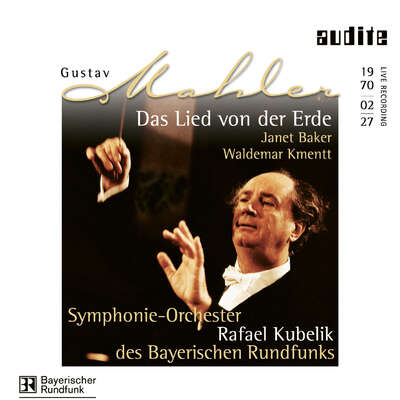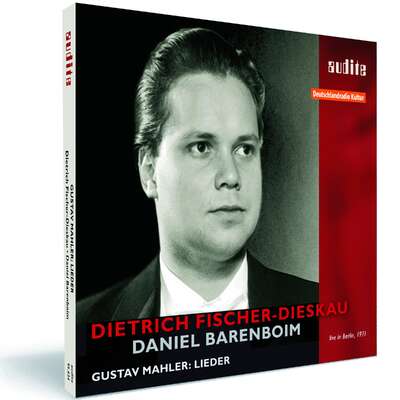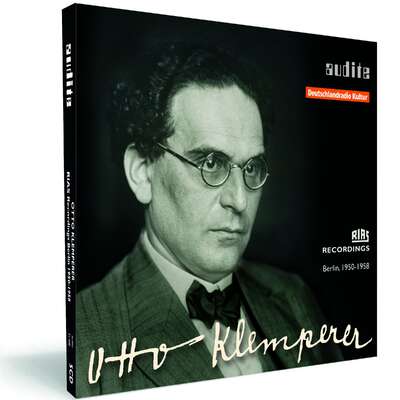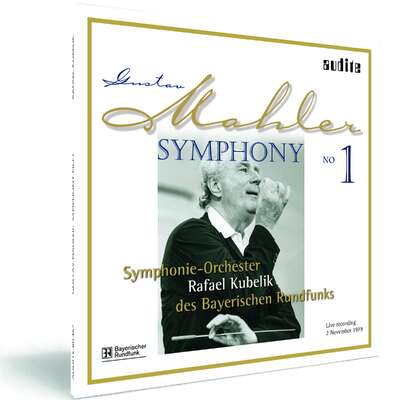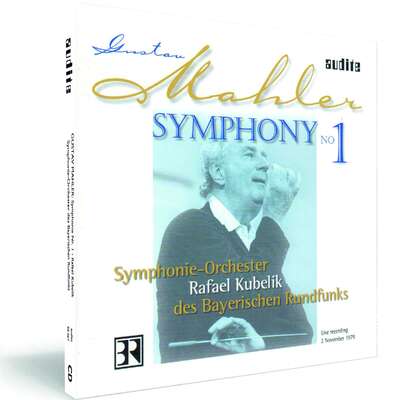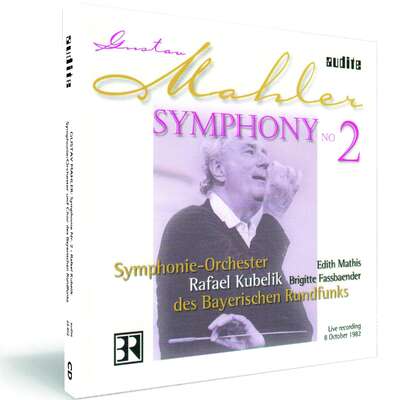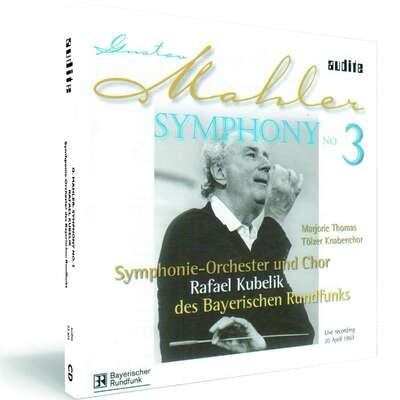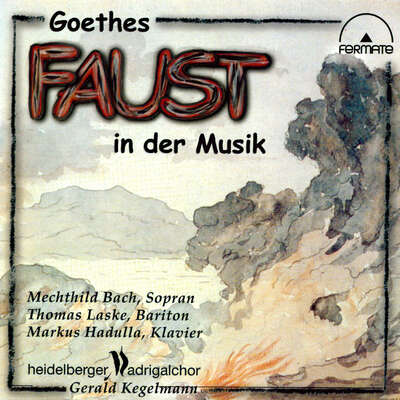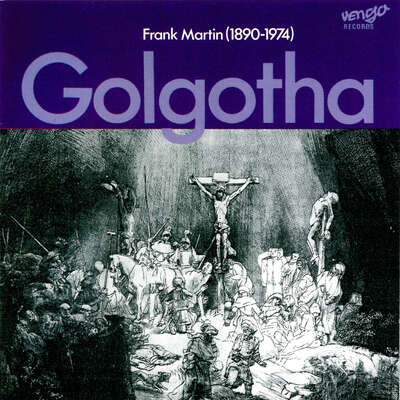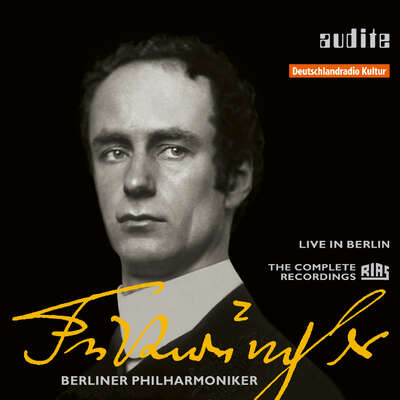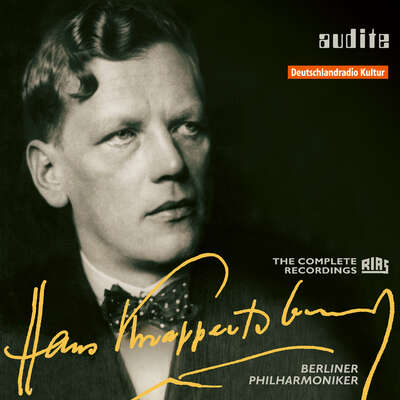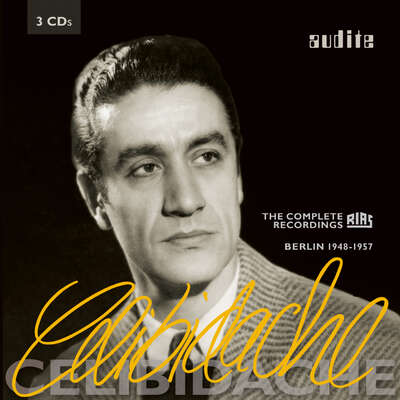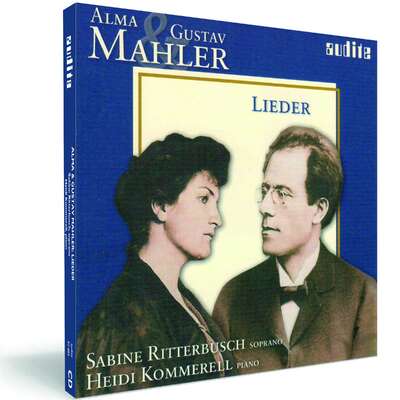
Im Jahre 1907 wurde Mahlers Leben durch mehrere Schicksalsschläge erschüttert: er musste wegen zunehmender Differenzen mit der Wiener Musikwelt und wegen anti-semitischer Anfeindungen als Direktor der Hofoper zurücktreten, seine geliebte Tochter Maria Anna starb qualvoll an Diphtherie, und...mehr
Im Jahre 1907 wurde Mahlers Leben durch mehrere Schicksalsschläge erschüttert: er musste wegen zunehmender Differenzen mit der Wiener Musikwelt und wegen anti-semitischer Anfeindungen als Direktor der Hofoper zurücktreten, seine geliebte Tochter Maria Anna starb qualvoll an Diphtherie, und...
Details
| Gustav Mahler: Das Lied von der Erde | |
| Artikelnummer: | 95.491 |
|---|---|
| EAN-Code: | 4022143954916 |
| Preisgruppe: | BCB |
| Veröffentlichungsdatum: | 1. Januar 2002 |
| Spielzeit: | 61 min. |
Zusatzmaterial
Informationen
Im Jahre 1907 wurde Mahlers Leben durch mehrere Schicksalsschläge erschüttert: er musste wegen zunehmender Differenzen mit der Wiener Musikwelt und wegen anti-semitischer Anfeindungen als Direktor der Hofoper zurücktreten, seine geliebte Tochter Maria Anna starb qualvoll an Diphtherie, und auch bei ihm selbst wurde ein schweres Herzleiden festgestellt, das ihn an den baldigen Tod denken ließ. In dieser fragilen Verfassung übte eine Gedichtsammlung des Literaten Hans Bethge eine besondere Faszination auf ihn aus. "Die chinesische Flöte", eine Sammlung von 80 Gedichten nach altchinesischen Quellen, kreist um die Themen Schönheit und Melancholie, ausufernde Trunkenheit und plötzliches Bewusstwerden der Vergänglichkeit. Mahler wählte sieben Gedichte aus und schuf daraus sechs musikalische Bilder (der "Abschied" fasst zwei Bilder zusammen) für eine Tenor- und eine Altstimme und Orchester. Mit dem Lied von der Erde gelang ihm die vollkommene Verschmelzung von Vokalem und Sinfonischem. Er selbst nannte das Lied von der Erde "das Persönlichste, was ich je geschrieben habe." Rafael Kubelik und das Sinfonieorchester des Bayerischen Rundfunks loten auch hier – wie schon in vielen bei audite erschienenen Sinfonien – Mahlers Expressivität in allen Facetten aus, ohne in hohles Pathos zu verfallen. Auch den Solisten Janet Baker und Waldemar Kmentt gelingt dieser Balanceakt mit Bravour. Das Werk erscheint in einer Live-Aufnahme aus dem Herkulessaal der Münchner Residenz vom 27. Februar 1978.
Besprechungen
www.amazon.de | 6. August 2019 | 6. August 2019 | Quelle: https://www.amaz... Completely outstanding
This is now my favourite Lied von der Erde. Everything seems right: soloists just superb, orchestra wonderfully transparent, ideal recording, with theMehr lesen
www.amazon.de | 8. Mai 2019 | Derek J. Johnston | 8. Mai 2019 | Quelle: https://www.amaz... Could this be the only Das Lied you'll ever need? Probably!
Please allow me to get the caveats out of the way before I say why I think this might be the only Das Lied you'll ever need: I'm very much a layMehr lesen
So why do I think this might be the only Das Lied you'll ever need? The answer is simple: intimacy. This is the only version of this piece of music I've heard that seems to have been played to and for the listener rather than at the listener. Whether that's because of how it was recorded or performed I couldn't say. Perhaps it's a combination of both. All I know is, is that when Janet Baker and Waldemar Kmentt sing, although especially when Janet is singing, I feel as though though they're singing to and for the listener, which in my case, is me. The goes for the orchestra: when they play, I feel as though they're playing to and for me.
There are probably many other recordings out there that sound better, clearer, less polluted by background noise. But I really feel that what is lost in audio quality with it being a live recording is gained in spades in musicality.
Like I say, I don't have the knowledge and experience to critique this performance from a technical point of view. I just want to confirm what others have said: that this is a genuine 5-star version of Das Lied... and probably the only one you'll ever need!
I should add, that although Herreweghe's reading (the Schoenberg-Riehn transcription) comes close in terms of that sense of intimacy, without Janet Baker on vocals, however, it just can't compete with this under-appreciated masterpiece.
ClicMag | N° 10s Novembre 2013 | Jérôme Angouillant | 1. November 2013
Deux figures légendaires de l'interprétation mahlérienne réunies à l'occasion d'un concert à Munich pour l'oeuvre peut-être la plus intime et douloureuse de Mahler: « Le chant de la terre ».Mehr lesen
The Jewish Daily Forward
| July 28, 2010 | Benjamin Ivry | 28. Juli 2010
A Lively Musical Corpus
Gustav Mahler, Almost a Century Dead and Still Kicking
Although other composers are most suitably celebrated on the anniversariesMehr lesen
The New York Sun | April 16, 2008 | Benjamin Ivry | 16. April 2008
In Stephen Sondheim's 1970 musical "Company," Elaine Stritch raspily sang aMehr lesen
www.new-classics.co.uk | January 2005 | 1. Januar 2005
In this outstanding live recording dating from 1970, Rafael Kubelik conducts the Bavarian Radio Symphony Orchestra in Mahler’s Das Lied von der ErdeMehr lesen
Lippische Landeszeitung | 05.02.2004 | fla | 5. Februar 2004
Historische Aufnahme ausgezeichnet
Label aus Hiddesen bekommt Cannes Classical Award
„Wir freuen uns sehr über diese Anerkennung“, heißt es bescheiden inMehr lesen
Badische Zeitung | 18.11.2003 | Heinz W. Koch | 18. November 2003
... Wie spezifisch, ja wie radikal sich Gielens Mahler ausnimmt, erhellt schlagartig, wenn man Rafael Kubeliks dreieinhalb Jahrzehnte alte und vorMehr lesen
Eine gehörige Überraschung gab’s schon einmal – als nämlich die nie veröffentlichten Münchner Funk-„Meistersinger“ von 1967 plötzlich zu haben waren. Jetzt ist es Gustav Mahlers drei Jahre später eingespieltes „Lied von der Erde“, das erstmals über die Ladentische geht. Es gehört zu einer Mahler Gesamtaufnahme, die offenbar vor der rühmlich bekannten bei der Deutschen Grammophon entstand. Zumindest bei den hier behandelten Sinfonien Nr. 3 und Nr. 6 war das der Fall. Beim „Lied von der Erde“ offeriert das Symphonie-Orchester des Bayerischen Rundfunks, dessen Chef Kubelik damals war, ein erstaunlich präsentes, erstaunlich aufgesplittertes Klangbild, das sowohl das Idyllisch-Graziöse hervorkehrt wie das Schwerblütig-Ausdrucksgesättigte mit großem liedsinfonischem Atem erfüllt – eine erstrangige Wiedergabe.
Auch die beiden 1967/68 erarbeiteten Sinfonien erweisen sich als bestechend durchhörbar. Vielleicht geht Kubelik eine Spur naiver vor als die beim Sezieren der Partitur schärfer verfahrenden Dirigenten wie Gielen, bricht sich, wo es geht, das ererbte böhmische Musikantentum zumindest für Momente Bahn. Da staunt einer eher vor Mahler, als dass er ihn zu zerlegen sucht. Wenn es eine Verwandtschaft gibt, dann ist es die zu Bernstein. Das Triumphale der „Dritten“, das Nostalgische an ihr wird nicht als Artefakt betrachtet, sondern „wie es ist“: Emotion zur Analyse. ...
(aus einer Besprechung mit den Mahler-Interpretationen Michael Gielens)
CD Compact | n°169 (octobre 2003) | Benjamín Fontvelia | 1. Oktober 2003 Rafael Kubelik/Audite
Sin la aparatosa presencia mediática de Karajan y Bernstein, en su rincónMehr lesen
Gramophone | October 2003 | Rob Cowan | 1. Oktober 2003 Kubelik takes the Stage
Some years ago I was involved in a discussion concerning Wilhelm Furtwängler's potential artistic heir. Who might he be? There was no lack ofMehr lesen
For example, compare Kubelik's 1975 DG studio recording of Beethoven's Fourth Symphony with the Israel Philharmonic with the live Bavarian RSO Audite version of four years later. The IPO account is taut and incisive, with an explosive fortissimo just before the coda (at 5'52", i.e. bar 312) that sounds as if it has been aided from the control desk. Turn then to the BRSO version, the lead-up at around 4'25" to that same passage (here sounding wholly natural), so much more gripping, where second fiddles, violas and cellos thrust their responses to tremolando first fiddles. The energy level is still laudably high but the sense of intense engagement is almost palpable. Again, with the Boston recording of the Fifth, handsome and well played as it undoubtedly is (and with the finale's repeat intact, which isn't the case on Audite), there is little comparison with the freer, airier and more responsive live relay. I'm thinking especially the slow movement, so humble and expressive, almost hymn-like in places – for example, the Bachian string counterpoint from 4'27''. Also, the Boston recording places first and second violins on the left: the Audite option has them divided, as per Kubelik’s preferred norm.
Audite’s Tchaikovsky coupling is an out-and-out winner. Kubelik made two studio recordings of the Fourth Symphony (with the Chicago SO and Vienna PO), both set around a lyrical axis, but this live version has a unique emotive impetuosity, especially in the development section of the first movement. The Andantino relates a burning nostalgia without exaggeration, whereas the scherzo – taken at a real lick – becomes a quiet choir of balalaikas. The April 1969 performance of the Violin Concerto was also Pinchas Zukerman's German début and aside from Kubelik's facilitating responsiveness, there's the warmth and immediacy of the youthful Zukerman's tone and the precision of his bowing. Both performances confirm Kubelik as among the most sympathetic of Tchaikovsky conductors, a genuine listener who relates what he hears, not what he wants to confess through the music.
Much the same might be said of Kubelik's Mahler, whether for DG or the various live alternatives currently appearing on Audite. In the case of ‘Das Lied von der Erde’ there is no DG predecessor, but even if there was, I doubt that it would surpass the live relay of February 1970 with Waldemar Kmentt and Dame Janet Baker, so dashing, pliant and deeply felt, whether in the subtly traced clarinet counterpoint near the start of ‘Von der Jugend’ or the way Baker re-emerges after the funereal processional in ‘Der Abschied’, as if altered forever by a profound visitation.
Scherzo | N° 178, Septiembre 2003 | Enrique Pérez Adrián | 1. September 2003
Una gran versión que sin duda hará mella espiritual en cualquier oyente sensible que se acerque a ella
Mathis, Brendel, Kmentt, Baker y Kubelik - Dos nuevas dianas
Audite nos trae dos nuevos conciertos de Rafael Kubelik de los años 70, deMehr lesen
El País
| 19.04.2003 | Javier Pérez Senz | 19. April 2003
Kubelik, en el corazón de Mahler
Dos sinfonías de Gustav Mahler grabadas en vivo abren la edición que el sello Audite dedica al director checo Rafael Kubelik, uno de los grandes mahlerianos de la historia.
[...] dirige el célebre adagietto con un encendido lirismo y una intensidad que hipnotiza al oyente –, situándose entre las mejores de la discografía.Mehr lesen
Flensborg Avis | 09.04.2003 | Lars Geerdes | 9. April 2003
Skelsættende tysk Mahlerindspilning genudgivet
Live-optagelse fra 1970 kan nu købes på cd
Da dirigenten Rafael Kubelik (1914-1996) i 1961 tiltrådte stillingen somMehr lesen
www.musicweb-international.com | 01.04.2003 | Tony Duggan | 1. April 2003
Here is one of the great "lost" Mahler recordings now properly restored. When Rafael Kubelik made his outstanding studio Mahler cycle in Munich for DGMehr lesen
For me Janet Baker has always been the greatest interpreter of the female/baritone songs in this work. Her Philips recording with Haitink on Eloquence (468 182-2) was long awaited even when it appeared and did not disappoint her admirers. In my survey of recordings of this work I believe I paid that version the attention it deserved singling out Baker for special praise. However even then I felt her interpretation on a BBC Radio Classics release taken from a later "live" performance in Manchester and conducted by Raymond Leppard was even better – deeper, more profound. The problem was that in no way could the BBC Northern Symphony Orchestra compare with the Concertgebouw, or her conductor Raymond Leppard compare with Bernard Haitink even though hearing Baker "live" seemed to add something to her interpretation. This was partly why when I heard the "pirate" of this Munich version I hoped for an official release. This too is "live" with all the benefit that brings but this time we have in Kubelik a Mahlerian of equal stature to Haitink and in the Bavarian Radio an orchestra that comes close to the Concertgebouw in depth of response to Mahler’s sound world. Matched with Waldemar Kmentt she also appears with a tenor who is, for me, superior to James King on the Haitink version and John Mitchinson on the Leppard, fine though both are.
The key to the greatness of Janet Baker in this work is her total identification with the words. Her care for every detail of them means she lives the part where some merely describe it. Her view of the music seems from the inside out. In these movements one thinks of Baker, Ludwig and Fassbaender among the women and Fischer-Dieskau among the men. In the second song you are made to feel what it is to be lonely rather than simply have loneliness described to you. Technically too she is on top form as the wild horses passage in "Von der Schönheit" proves. At no point in this crazy music does Baker ever give the impression that she will come to grief, even though the tempo adopted by her and Kubelik is suitably swift. They had one shot at this in front of an audience and it comes off triumphantly. Listen also to the delicacy of the description of the young girls swimming in the same movement. Finally in the "Abschied" her range, emotional and musical is total. Everything is covered here from the passages of sterile enunciation to the overwhelming emotional grandeur of the climaxes and all points between subtly graded. Overall this is one of those interpretations that contain depths that will take years to plumb.
Of all the great recordings of this work I know there has, for me, so far only been one where I feel that two of the greatest interpreters are matched on the same recording. These are Christa Ludwig and Fritz Wunderlich for Klemperer on EMI. But now with this release I think there is a second since Waldemar Kmentt is just as convincing in his songs as Janet Baker is in hers. In fact I believe Kmentt can be compared with Wunderlich, Peter Schreier and Julius Patzak as the finest interpreters in the tenor songs on record. In "Das Trinklied" Kmentt is towering, challenging the music to break him in the dramatic sections, but emerging unscathed from them. The "Dark is life, is death" refrain has a world-weary depth that few save Schreier and Wunderlich can match and the "ape on the grave" climax is fearless in his nightmarish delivery. Like Baker, Kmentt can also walk the delicate passages of this work with equal effect. His description of the arrival of spring in "Der Trunkene im Fruhling" is magical and his word painting in "Von Der Jugend" piquant and sharp.
Kubelik’s greatness as a Mahler conductor was his ability to cover the whole range of the music from uncomplicated nature painting to calculated high drama and seem equally at home everywhere. He attends to all details of this music with care and discretion, always taking care of the bigger picture too, balancing it with the inner detail. Notice the woodwinds during the funeral march in "Der Abscheid" where every strand is clearly delineated, or the effect of getting his mandolin to play tremolo in the same movement marking up the chinoiserie in a most evocative and unique way. He also recognises what I have always believed to be a crucial aspect of this work. That the two soloists are the equal partners with the conductor and that he is there to support them. With great soloists like these, that is easier. But countless examples of his support for his soloists are apparent in this performance along with the preparation of his orchestra to act almost as a third soloist. The purely instrumental passages in "Der Abschied" reveal Mahler conducting of the highest order. Listen to the birds passage and also to the deep bass growls before the funeral march.
The sound recording leaves little to be desired. It is hard to tell it was made over thirty years ago for radio broadcast. I like the balances between woodwind and strings and the warmth of the acoustic around the orchestra and soloists in the chamber-like sections. The balance between soloists and orchestra are exemplary also. Even the distinctive acoustic of the Herkulessaal is made to sound perfectly suited to the music. You can hear everything and with solo players in the orchestra as eloquent as the two singers are this is important and adds another plus to this disc. In sound terms this more than matches the best versions of this work and musically it is the equal of Klemperer on EMI (5 66892 2), Sanderling on Berlin Classics (0094022BC) and Horenstein on BBC Legends (BBCL 4042-2). All very different though each one of those comparable versions are in their interpretative approach. Indeed, this Kubelik recording has the effect of taking many of the virtues of all those great recordings and stitching them into a new and deeply satisfying whole.
This is one of the all-time great Mahler recordings: a classic version of this inexhaustible masterpiece in every way. Indeed I think there are none to surpass it, perhaps only to equal it. You will be moved, delighted and changed by it. I cannot recommend it too highly as it goes to the top of my list for this work.
Nordsee-Zeitung | Nr. 57/2003 | Sebastian Loskant | 8. März 2003
Es war ein Tscheche, der den Münchenern den Spätromantiker Gustav MahlerMehr lesen
Das Orchester | 3/2003 | Johannes Killyen | 1. März 2003
Um eines von Gustav Mahlers großen Werken neu auf dem übersättigtenMehr lesen
Die Rheinpfalz | 12.02.2003 | Gerhard Tetzlaf | 12. Februar 2003 Idealer Interpret – Livemitschnitte unter Rafael Kubelik
Die Gesamtaufnahme der Sinfonien Gustav Mahlers durch Rafael Kubelik undMehr lesen
Stereoplay | 1/2003 | Ulrich Schreiber | 1. Januar 2003
Marktpolitisch mag der Audite-Versuch, dem von der DG im Studio fixiertenMehr lesen
klassik.com | 19.12.2002 | Erik Daumann | 19. Dezember 2002 | Quelle: http://magazin.k... Von Böhme zu Böhme
Das Label ‚audite’ des Diplom-Tonmeisters Ludger Böckenhoff ausMehr lesen
WDR 3 | 03.12.2002 | Michael Schwalb | 3. Dezember 2002
Hörproben-Neue CDs, am Mikrophon Michael Schwalb. Mitgebracht habe ichMehr lesen
klassik-heute.com | 02.12.2002 | Mario Gerteis | 2. Dezember 2002
In der ersten Mahler-Welle auf (Stereo-)Schallplatten spielte derMehr lesen
Fono Forum | 11/02 | Christian Wildhagen | 1. November 2002 Glücksgriff
Dieser Live-Mitschnitt stellt eine echte Erweiterung der Kubelik-Diskographie dar, denn "Das Lied von der Erde" fehlt in seinem Studio-Mahler-Zyklus.Mehr lesen
Rondo | 17.10.202 | Matthias Kornemann | 17. Oktober 2002
Viele Dirigenten hat es am Jahrhundertende angezogen, dieses "Lied von derMehr lesen
International Record Review | 10/2002 | Christopher Breuning | 1. Oktober 2002
The German firm Audite has given us not only this near complete live cycle of Mahler symphonies (sans 4 or 8), but valuable Kubelik/Curzon readings ofMehr lesen
Recorded between 1967 and 1971, Kubelik's DG cycle has been at budget price for some time now (Collector 463 738-2, ten discs) and the Audite alternatives of 1, 5 and 7 have been in the shops for months. The NHK-recorded Ninth (Audite 95471), made during a 1975 Tokyo visit by the Bavarian RSO, was reviewed in CRC, Spring 2001 (I found the sound unfocused and the brass pinched in sound, but welcomed in particular playing ‘ablaze’ after the visionary episode in the Rondo burleske and a crowning finale). No. 1 on DG is widely admired but this 1979 version is more poetic still, wonderfully so in the introduction and trio at (II). There is something of a pal of resonance in place of applause, cut from all these Audite transfers. In No.7 the balance is more airy than DG’s multi-miked productions, and (as in No.5) Kubelik sounds less constrained than when working under studio conditions, although rhythm in the opening bars of (II) goes awry and the very opening note is succeeded by a sneeze! The disturbing and more shadowy extremes are more vividly characterised, the finale a riotous display.
Some critics feet that Kubelik gives us ‘Mahler-lite’ which may seem so in comparison with, say, Chailly's Decca cycle or the recent BPO/Abbado Third on DG – not to mention Bernstein's. But there is plenty of energy here, and the divided strings with basses set to the rear left give openness to textures. However, the strings are not opulent and the trumpets are often piercing. It would be fair to say that Kubelik conducted Mahler as if it were Mozart!
As it happens, in the most controversial of his readings, No. 6, the DG is preferable to the Audite, where Kubelik projects little empathy with its slow movement and where the Scherzo is less cohesive. The real problem is that the very fast speed for (I) affects ail subsequent tempo relationships. Nor does the finale of No. 3. one of the glories of the DG cycle, quite have that same radiance; the singers are the same, the Tölz Boys making a sound one imagines Mahler must have beard in his head, and this performance predates the DG by one month. Nevertheless, these newer issues of Nos 2 and 3 are worth hearing, the ‘Resurrection’ not least for Brigitte Fassbaender's account of the ‘Urlicht’.
Nowadays, every orchestra visiting London seems to programme Mahler's Fifth Symphony as a Showpiece, but in 1951 (when Bruno Walter's 78rpm set was the collector's only choice) a performance would surely have been uncommon even at the Concertgebouw – Mengelberg was prohibited from conducting in Holland from 1946 until he died that year. Although the start of (V) is marred by the horns, this is an interesting, well executed account with a weightier sound, from what one can surmise through the inevitable dimness – the last note of (I) is almost inaudible. The three versions vary sufficiently to quote true timings (none is given by Tahra): (I) 11m 34s/12m 39s/11m 35s (Tahra/Audite/DG); (II) 13m/14m 52s/13m 52s; (III) 15m 56s/17m 54s/17m 23s; (IV) 9m 24s/10m 24s/9m 44s); (V) 14m 26s/14m 57s/15m 29s. The live Munich version is tidier than on DG; the spectral imagery in (III) is
heavier in effect, too; and in the Adagietto the dynamic and phrasing shadings and poetic quality of the string playing also give the live performance the edge. Towards the end of the finale, and elsewhere the engineers reduced dynamic levels.
Tahra's booklet comprises an untidily set-out synopsis of Kubelik's career. Audite's have full description of the works with texts for Nos 2 and 3, and different back-cover colour portraits of the conductor.
www.amazon.de | 1. Oktober 2002 | 1. Oktober 2002 | Quelle: https://www.amaz... Fernöstliche Musik ganz nah!
Rafael Kubelik beschreitet sicher den Grat zwischen romantisch üppigem Klang und klassischer Genauigkeit, lässt die Musik weit schwingen, dasMehr lesen
Pizzicato | 10.2002 | Rémy Franck | 1. Oktober 2002 Optimistisches 'Lied von der Erde'
Kubelik hat für die Deutsche Grammophon die Mahler-Symphonien aufgenommen, nicht aber 'Das Lied von der Erde'. Nachdem uns etliche derMehr lesen
Audite legt also mit dieser CD eine in der Interpretationsgeschichte vom 'Lied von der Erde' eine essentielle Interpretation vor, die unsere Sicht auf dieses von Mahler als sein persönlichstes Werk bezeichnete Komposition völlig erneuert.
Classic Record Collector | 10/2002 | Christopher Breunig | 1. Oktober 2002
The German firm Audite has given us not only this near complete live cycle of Mahler symphonies (sans 4 or 8), but valuable Kubelik/Curzon readings ofMehr lesen
Recorded between 1967 and 1971, Kubelik’s DG cycle has been at budget price for some time now and the Audite alternatives of 1, 5 and 7 have been in the shops for months. The NHK-recorded Ninth, made during a 1975 Tokyo visit by the Bavarian RSO, was reviewed in CRC, Spring 2001 (I found the sound unfocused and the brass pinched in sound, but welcomed in particular playing ‘ablaze’ after the visionary episode in the Rondo burleske and a crowning final). No. 1 in DG is widely admired but this 1979 version is more poetic still, wonderfully so in the introduction and trio at (II). There is something of a pall of resonance in place of applause, cut from all these Audite transfers. In No. 7 the balance is more airy than DG’s multi-miked productions, and (as in No. 5) Kubelik sounds less constrained than when working under studio conditions, although rhythm in the opening bars of (II) goes awry and the very opening note is succeeded by a sneeze! The disturbing and more shadowy extremes are more vividly characterized, the finale a riotous display.
Some critics feel that Kubelik gives us ‘Mahler-lite’, which may seem in comparison with, say, Chailly’s Decca cycle or the recent BPO/Abbado Third on DG – not to mention Bernstein’s. But there is plenty of energy here, and the divided strings with basses set to the rear left give openness to textures. However, the strings are not opulent and the trumpets are often piercing. It would be fair to say that Kubelik conducted Mahler as if it were Mozart!
As it happens, in the most controversial of his readings, No. 6, the DG is preferable to the Audite, where Kubelik projects little empathy with its slow movement and where the Scherzo is less cohesive. The real problem is that the very fast speed for (I) affects ail subsequent tempo relationships. Nor does the finale on No. 3, one of the glories of the DG cycle, quite have the same radiance; the singers are the same, the Tölz Boys making a sound one imagines Mahler must have heard in his head, and this performance predates the DG by one month. Nevertheless, these newer issues of Nos 2 and 3 are worth hearing, the ‘Resurrection’ not least for Brigitte Fassbaender’s account of ‘Urlicht’.
Nowadays every orchestra visiting London seems to programme Mahler’s Fifth Symphony as a showpiece, but in 1951 (when Bruno Walter’s 78rpm set was the collector’s only choice) a performance would surely have been uncommon even at the Concertgebouw – Mengelberg was prohibited from conducting in Holland from 1946 until he died that year. Although the start of (V) is marred by horns, this is an interesting, well executed account with a weightier sound, from what one can surmise through the inevitable dimness – the last note of (I) is almost inaudible. The three versions vary sufficiently to quote true timings (none is given by Tahra): (I) 11m 34s/12m 39s/11m 35s (Tahra/Audite/DG); (II) 13m/14m 52s/13m 52s; (III) 15m 56s/17m 54s/17m 23s; (IV) 9m 24s/10m 24s/9mm 44s); (V) 14m 26s/14m 57s/15m 29s. The live Munich version is tidier than on DG; the spectral imagery in (III) is heavier in effect, too; and in the Adagietto the dynamic and phrasing shadings and poetic quality of the string playing also give the live performance the edge. Towards the end of the finale, and elsewhere, the engineers reduced dynamic levels.
Tahra’s booklet comprises an untidily set-out synopsis of Kubelik’s career. Audite’s have full descriptions of the works with text for Nos 2 and 3, and different back-cover colour portraits of the conductor.
Répertoire | No 161 | Gérard Belvire | 1. Oktober 2002
Avec Bernstein, Solti et Haitink, Kubelik fait partie des chefs «Mehr lesen
Gramophone | 9/2002 | Richard Fairman | 1. September 2002 Das Lied live from two great Mahler conductors‚ more spontaneous sounding than their studio versions
Audite is in the process of assembling a complete Mahler cycle with Kubelík and the Bavarian RSO from radio relays. So far the recordings date acrossMehr lesen
Some may prefer to stick with studio recordings of Das Lied‚ where the orchestra has had the luxury of extra takes to polish every detail‚ but there are no complaints about the Bavarian orchestra here. There are also a few studio recordings (Karajan and the Solti among them) that perform technical somersaults to end up with a recorded balance less satisfying than here.
Diapason | Septembre 2002 | Jean-Charles Hoffele | 1. September 2002
Deutsche Gramophon ne permit pas à Kubelik d’enregistrer « Le Chant de la terre », qui aurait constitué le point d’orgue de son cycle Mahler ;Mehr lesen
Porté par cet orchestre éclairé, l’alto de Baker ose un chant rayonnant, débarrassé de toute tentation d’assombrir le timbre (ce qu’elle réussissait admirablement avec Haitink, Philips), magnifié par une petite harmonie et des violons tenus par la direction sostenuto de Kubelik, qui semble omniprésente dans toutes les pupitres de l’orchestre, à tous les instants, distillant une immense musique du chambre. Kmentt, en grande voix, tranchant, héroïque, impressionne durablement et ne pâlit ni devant la beauté absolue de Wunderlich ni devant le « sprechgesang » enflammé de Patzak. Dans la plénitude de son geste, Kubelik entend « Le Chant de la terre » comme une partition ouverture sur l’avenir, tournant les dos aux vastes thrènes funèbres des grandes versions de l’œuvre, sentimentaux et étreignant (Walter, Bernstein, Haitink), minéraux et tragiques (Reiner, Klemperer). Il renouvelle totalement notre vision d’une partition-clé du début du siècle.
www.buch.de | 08.07.2002 | Olaf Behrens | 8. Juli 2002
Bisher sind nur Live-Einspielungen der Werke Mahlers unter Rafael KubelikMehr lesen
www.ClassicsToday.com | 01.01.1000 | David Hurwitz | 1. Januar 2002
Rafael Kubelik never made a studio recording of Das Lied von der Erde, butMehr lesen


